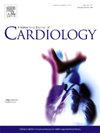皮下ICD运动安全登记(SISS登记)。
IF 3.2
2区 医学
Q2 CARDIAC & CARDIOVASCULAR SYSTEMS
引用次数: 0
摘要
背景:运动对身体功能和生活质量有积极的影响。然而,使用植入式心律转复除颤器(ICD)的个体在体育活动中可能会出现不良事件。迄今为止,关于皮下icd (s - icd)患者参与运动的安全性的科学数据缺乏。本研究旨在分析S-ICD患者中与体育活动相关的适当和不适当的心律失常事件的发生情况。方法:选取连续行S-ICD植入术的患者。收集了基线临床数据,以及体育活动和心律失常事件的信息。结果:在登记的280例患者中(中位年龄46岁[32-55岁],男性72 %),205例(73 %)参加体育活动。在38 ± 13 个月的随访期间,27例患者(13 %)经历了适当的电击。其中,20例(74.1 %)发生在休息时,7例(25.9 %)发生在运动表现最佳时。所有接受适当电击的患者都被植入二级预防。此外,27例患者(13.1 %)经历了不适当的电击,其中15例(55.6% %)发生在休息时,12例(44.4% %)发生在体力活动高峰时,主要是由于t波过度敏感。在经历过电击的患者和没有经历过电击的患者之间,没有观察到运动类型或强度的显著差异。结论:在S-ICD患者中,适当和不适当的电击在体能表现高峰期发生的频率更高,但与运动类型或强度无关。适当电击在致心律失常或缺血性心肌病患者中最为常见,而不适当电击主要是由于t波过感所致。本文章由计算机程序翻译,如有差异,请以英文原文为准。

Subcutaneous ICD sports safety registry (SISS registry)
Background
Exercise has a positive impact on physical function and quality of life. However, individuals with an implantable cardioverter-defibrillator (ICD) may experience adverse events during sports activities. To date, scientific data on the safety of sports participation in patients with subcutaneous ICDs (S-ICDs) are lacking. This study aims to analyze the occurrence of appropriate and inappropriate arrhythmic events related to sports activity in a population of S-ICD patients.
Methods
Consecutive patients who underwent S-ICD implantation were enrolled. Baseline clinical data, as well as information on sports activity and arrhythmic events, were collected.
Results
Among 280 patients (median age 46 [32–55] years; 72 % male) included in the registry, 205 (73 %) engaged in sports activities. During a follow-up period of 38 ± 13 months, 27 patients (13 %) experienced appropriate shocks. Of these, 20 (74.1 %) occurred at rest and 7 (25.9 %) during peak performance in sports. All patients who received appropriate shocks were implanted for secondary prevention.
Additionally, 27 patients (13.1 %) experienced inappropriate shocks, with 15 (55.6 %) occurring at rest and 12 (44.4 %) during peak physical activity, primarily due to T-wave oversensing. No significant differences were observed in type or intensity of sports activity between patients who experienced shocks and those who did not.
Conclusion
In S-ICD patients, both appropriate and inappropriate shocks occur more frequently during peak physical performance but are not associated with the type or intensity of sports activity. Appropriate shocks were most common in patients with arrhythmogenic or ischemic cardiomyopathy, while inappropriate shocks were mainly due to T-wave oversensing.
求助全文
通过发布文献求助,成功后即可免费获取论文全文。
去求助
来源期刊

International journal of cardiology
医学-心血管系统
CiteScore
6.80
自引率
5.70%
发文量
758
审稿时长
44 days
期刊介绍:
The International Journal of Cardiology is devoted to cardiology in the broadest sense. Both basic research and clinical papers can be submitted. The journal serves the interest of both practicing clinicians and researchers.
In addition to original papers, we are launching a range of new manuscript types, including Consensus and Position Papers, Systematic Reviews, Meta-analyses, and Short communications. Case reports are no longer acceptable. Controversial techniques, issues on health policy and social medicine are discussed and serve as useful tools for encouraging debate.
 求助内容:
求助内容: 应助结果提醒方式:
应助结果提醒方式:


